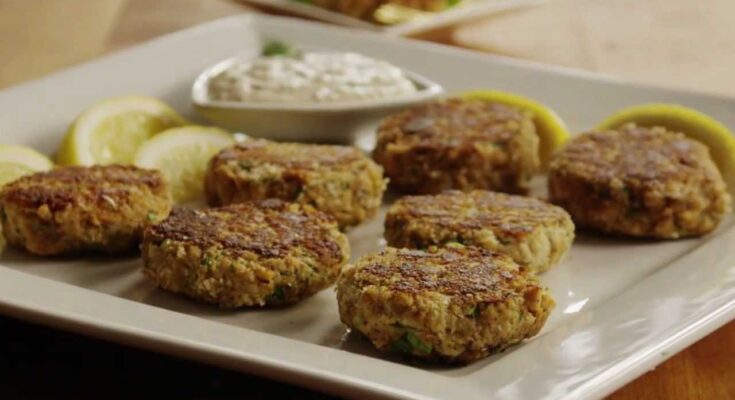Salmon Cake Recipe: Salmon cakes are a delicious, versatile dish perfect for any occasion. Whether you’re looking for a quick weeknight meal, a healthy lunch option, or an appetizer to impress your guests, these salmon cakes are a crowd-pleaser. Packed with protein, omega-3 fatty acids, and rich flavors, they’re not just tasty but also nutritious.
In this guide, you’ll learn how to make salmon cakes from scratch, step-by-step. We’ll cover everything from choosing ingredients to shaping, cooking, and serving them.
Let’s dive right in!
Ingredients for Salmon Cakes
Before we get started, let’s gather all the ingredients you need.
Main Ingredients:
- Salmon – 1 pound (fresh or canned)
- Breadcrumbs – 1 cup (plain or seasoned)
- Eggs – 2 large (for binding)
- Mayonnaise – 2 tablespoons (adds moisture)
- Dijon Mustard – 1 tablespoon (adds flavor)
- Lemon Juice – 1 tablespoon (for a zesty taste)
- Onion – ½ cup, finely diced
- Garlic – 2 cloves, minced
- Fresh Parsley – 2 tablespoons, chopped
- Salt and Pepper – To taste
Optional Add-Ons:
- Hot Sauce – For a spicy kick
- Capers – Adds a briny flavor
- Green Onions – For garnish and crunch
Fresh vs. Canned Salmon
Fresh Salmon: Ideal for richer flavors but requires cooking beforehand. Perfect for special occasions.
Canned Salmon: A budget-friendly and time-saving alternative. It’s pre-cooked and great for quick recipes.
Kitchen Tools Needed
To make salmon cakes seamlessly, have the following tools ready:
- Mixing Bowls – For combining ingredients.
- Knife and Cutting Board – For chopping herbs and vegetables.
- Non-Stick Skillet or Frying Pan – For frying the cakes.
- Baking Sheet and Parchment Paper – If baking instead of frying.
- Spatula – For flipping the cakes without breaking them.
Preparing the Salmon
The first step is preparing the salmon. Depending on whether you use fresh or canned salmon, the process varies slightly.
Cooking Fresh Salmon
- Season the Salmon: Sprinkle salt, pepper, and a drizzle of olive oil.
- Bake or Pan-Sear: Bake at 375°F (190°C) for 12–15 minutes or pan-sear until cooked through.
- Flake the Salmon: Once cooled, use a fork to flake the cooked salmon into small pieces, removing bones or skin.
Using Canned Salmon
- Drain Well: Remove excess liquid from the can.
- Inspect for Bones: Although most canned salmon is deboned, double-check and remove any unwanted pieces.
- Flake the Meat: Use a fork to break the salmon into smaller chunks.
Mixing the Ingredients
The secret to moist and flavorful salmon cakes lies in the mixture. Here’s how to combine everything effectively.
Essential Binding Ingredients
- Eggs: These hold the mixture together, preventing the cakes from falling apart.
- Breadcrumbs: They add texture and absorb moisture, keeping the cakes firm but not dry.
- Mayonnaise and Mustard: Provide creaminess and tanginess.
Flavor Enhancers and Spices
- Lemon Juice: Adds brightness to the flavor.
- Garlic and Onion: Provide depth and aroma.
- Fresh Herbs: Parsley and dill elevate freshness.
Steps to Combine Ingredients:
- In a large mixing bowl, add the flaked salmon.
- Stir in eggs, mayonnaise, mustard, lemon juice, and seasonings.
- Gradually fold in breadcrumbs until the mixture binds well.
- Mix gently but thoroughly to ensure even distribution of flavors.
Shaping the Salmon Cakes
Shaping the salmon cakes is a crucial step to ensure they cook evenly and hold their form. Here’s how to do it:
- Portion the Mixture: Use a 1/3-cup measuring cup or a large spoon to scoop out equal portions of the mixture. This ensures uniform size, which helps with even cooking.
- Shape into Patties: Roll the portioned mixture into a ball, then flatten it gently with your palms to form a patty about 1/2 to 3/4 inch thick.
- Chill the Patties (Optional): Place the patties on a baking sheet lined with parchment paper. Chill them in the refrigerator for 20–30 minutes to help them firm up. This prevents them from falling apart during cooking.
Pro Tip: If the mixture feels too wet, add more breadcrumbs. If it’s too dry, add a little mayonnaise or a splash of lemon juice.
Cooking Methods for Salmon Cakes
Salmon cakes can be prepared in several ways, depending on your preference for texture and convenience.
1. Pan-Frying Method
Pan-frying is the most common method, offering a crispy outer layer and a moist interior.
Steps:
- Heat 2–3 tablespoons of olive oil or butter in a non-stick skillet over medium heat.
- Once the oil is hot, add the salmon cakes in batches, leaving enough space between them.
- Cook for 3–4 minutes per side or until golden brown and crispy.
- Transfer to a paper towel-lined plate to remove excess oil.
Pros: Quick and gives a delicious crispy crust.
Cons: Requires more oil and attention to prevent burning.
2. Baking Method
Baking is a healthier alternative and reduces hands-on cooking time.
Steps:
- Preheat your oven to 400°F (200°C).
- Arrange the patties on a baking sheet lined with parchment paper. Lightly spray or brush them with oil.
- Bake for 15–20 minutes, flipping halfway through, until golden brown.
Pros: Healthier and less messy than frying.
Cons: May lack the crispiness of pan-frying.
3. Air Frying Method
For a quick, low-oil option, air frying is perfect.
Steps:
- Preheat the air fryer to 375°F (190°C).
- Lightly spray the patties with oil and arrange them in a single layer in the air fryer basket.
- Cook for 8–10 minutes, flipping halfway through, until golden brown.
Pros: Healthiest method with minimal oil use.
Cons: Limited capacity; may need to cook in batches.
Serving Suggestions
Salmon cakes are versatile and can be served in many creative ways. Here are some ideas:
- As a Main Course: Serve with a fresh green salad, roasted vegetables, or mashed potatoes.
- In a Sandwich: Place a salmon cake in a bun with lettuce, tomato, and tartar sauce for a salmon burger.
- Appetizer Style: Serve smaller patties as bite-sized appetizers with dipping sauces.
- Over Grains: Pair with quinoa, rice, or couscous for a wholesome meal.
Toppings and Sauces for Salmon Cakes
Elevate your salmon cakes with these tasty toppings and sauces:
- Tartar Sauce: A classic choice with a tangy flavor.
- Aioli: Garlic or lemon aioli adds creaminess.
- Yogurt Sauce: Greek yogurt mixed with dill and lemon juice for a healthy alternative.
- Spicy Mayo: Mix mayonnaise with Sriracha for a spicy kick.
- Avocado Slices: Adds creaminess and freshness.
Side Dishes to Complement Salmon Cakes
Pairing salmon cakes with the right side dishes can turn them into a complete, satisfying meal. Here are some perfect options to complement their flavor and texture:
1. Fresh Salads
- Mixed Green Salad: Toss leafy greens with cherry tomatoes, cucumber, and a light vinaigrette for a refreshing side.
- Coleslaw: A tangy coleslaw made with cabbage, carrots, and a creamy dressing adds crunch and balance.
- Cucumber Salad: Thinly sliced cucumbers with red onion and a dill vinaigrette create a cool contrast to the warm salmon cakes.
2. Roasted Vegetables
- Asparagus: Roast asparagus with garlic and parmesan for a crispy, flavorful side.
- Brussels Sprouts: Toss them with olive oil and roast until golden for a caramelized crunch.
- Sweet Potatoes: Roasted sweet potato wedges provide sweetness and pair well with the savory cakes.
3. Grains and Starches
- Rice Pilaf: Light and fluffy rice seasoned with herbs complements the cakes without overpowering them.
- Quinoa Salad: Protein-packed quinoa with vegetables and lemon dressing adds both flavor and nutrition.
- Mashed Potatoes: Creamy mashed potatoes make for a hearty side, perfect for colder months.
4. Light Soups
- Tomato Soup: A rich and creamy tomato bisque is a great pairing option.
- Corn Chowder: Its sweet and savory flavors highlight the richness of the salmon.
- Gazpacho: A chilled vegetable soup adds freshness and contrast.
Storage and Reheating Tips
Whether you have leftovers or want to make salmon cakes in advance, proper storage and reheating methods ensure they stay delicious.
Storage Tips:
- Refrigeration: Place the cooled salmon cakes in an airtight container. Store them in the refrigerator for up to 3 days.
- Freezing: Lay the cakes on a baking sheet in a single layer and freeze until solid. Transfer them to a freezer bag and store for up to 3 months.
Reheating Methods:
- Oven: Preheat to 350°F (175°C). Place the cakes on a baking sheet and heat for 10–12 minutes until warmed through.
- Skillet: Reheat over medium heat with a splash of oil for 3–4 minutes on each side.
- Air Fryer: Heat at 350°F (175°C) for 5–7 minutes for a crispy texture.
- Microwave (Not Recommended): If you’re short on time, microwave for 1–2 minutes, but note this may make them slightly soggy.
Nutritional Value of Salmon Cakes
Salmon cakes are not only flavorful but also packed with nutrients. Let’s break down their health benefits:
- Protein-Rich: Salmon is an excellent source of lean protein, essential for muscle growth and repair.
- Omega-3 Fatty Acids: These heart-healthy fats support brain function and reduce inflammation.
- Vitamins and Minerals: Rich in Vitamin D, B12, and selenium, salmon cakes contribute to better bone health and immunity.
- Low Carb Options: By using almond flour instead of breadcrumbs, you can make them keto-friendly.
Sample Nutrition (Per Serving):
| Nutrient | Amount (Approx.) |
|---|---|
| Calories | 200–250 kcal |
| Protein | 15–20g |
| Fat | 12–15g |
| Carbohydrates | 10–12g |
| Fiber | 1–2g |
| Omega-3 Fatty Acids | 1.5–2g |
Tips for Perfect Salmon Cakes
Creating perfect salmon cakes every time requires a few tips and tricks:
- Choose the Right Salmon: Fresh salmon provides a richer flavor, but canned salmon is a great time-saver. Drain canned salmon well to avoid sogginess.
- Don’t Skip the Binder: Eggs and breadcrumbs help hold the cakes together. Adjust the ratio to avoid crumbling.
- Chill Before Cooking: Refrigerating the patties for at least 20 minutes ensures they hold their shape during cooking.
- Season Generously: Taste the mixture before shaping to make sure it’s seasoned well. Adding herbs and spices enhances the flavor.
- Cook on Medium Heat: Cooking on too high heat can burn the outside while leaving the inside undercooked. Stick to medium heat for even cooking.
- Flip Carefully: Use a flat spatula to flip the cakes gently and avoid breaking them apart.
Common Mistakes to Avoid
Avoid these pitfalls to ensure your salmon cakes turn out perfectly:
- Over-Mixing the Ingredients: This can make the cakes dense and tough. Gently mix just until combined.
- Skipping the Chill Time: If you skip chilling the patties, they might fall apart during cooking.
- Using Too Much Moisture: Overdoing the mayonnaise or lemon juice can make the mixture too wet. Adjust with breadcrumbs if needed.
- Cooking at High Heat: High heat may burn the crust without cooking the inside. Medium heat is the key.
- Not Testing the Mixture: Always taste the mixture before forming patties to ensure it’s seasoned properly.
FAQs about Salmon Cake Recipe
What ingredients do I need for a basic salmon cake recipe?
To make basic salmon cakes, you will need canned salmon, bread crumbs or crushed crackers, eggs, mayonnaise, and seasoning such as salt, pepper, and dill. Optional additions include diced onions, celery, and bell peppers for extra flavor and crunch.
How do I ensure my salmon cakes don’t fall apart?
To prevent your salmon cakes from falling apart, make sure the mixture is not too wet or dry. The right amount of binding agents, like bread crumbs and eggs, will help hold the mixture together. Also, let the cakes chill in the refrigerator for about 30 minutes before frying; this step helps them maintain their shape.
Can I make salmon cakes with fresh salmon instead of canned?
Absolutely! Fresh salmon can be cooked and flaked to substitute for canned salmon in cakes. Boil, steam, or lightly sauté the salmon, then flake it with a fork and follow the same recipe steps.
What are the best side dishes to serve with salmon cakes?
Salmon cakes pair well with a variety of side dishes. Some popular options include a light salad, steamed vegetables, roasted potatoes, or a creamy dill sauce. For a heartier meal, serve them with rice or quinoa.
Are salmon cakes healthy?
Salmon cakes are a great source of protein and omega-3 fatty acids, especially when made with minimal added fats and whole-food ingredients. They can be part of a healthy diet, particularly if you use heart-healthy oils for cooking and include plenty of vegetables in your meal.
Can I freeze salmon cakes?
Yes, salmon cakes can be frozen for future use. To freeze, first cook the cakes and let them cool completely. Place them on a baking sheet in the freezer to flash freeze. Once solid, transfer them to a freezer-safe bag or container. They can be stored for up to three months.
Conclusion
Salmon cakes are a flavorful, versatile dish that’s easy to make and perfect for any occasion. Whether you’re preparing them as a quick weekday meal or serving them at a gathering, their crispy texture and rich taste are sure to impress. With the right ingredients, cooking methods, and side dishes, you can create a balanced, healthy meal that everyone will love. Follow this guide step-by-step, and you’ll have perfect salmon cakes every time!



